Integrated Marketing Communication and Brand Awareness Review
VerifiedAdded on 2022/08/15
|12
|2753
|364
Literature Review
AI Summary
This literature review examines the impact of Integrated Marketing Communication (IMC) on brand awareness, exploring the relationship between IMC and brand awareness. The review discusses key concepts such as IMC business processes, resource allocation, marketing communication mix, brand recognition, brand recall, top-of-mind awareness, and brand domination. It synthesizes findings from various research papers, highlighting the importance of consistent messaging across different channels and the influence of extraneous variables like lack of commitment, resources, expertise, and strategic intent. The review also explores how brand awareness is affected by the product life cycle and various marketing communication tools. The study concludes that while IMC significantly impacts brand awareness, its effectiveness is influenced by these extraneous factors.
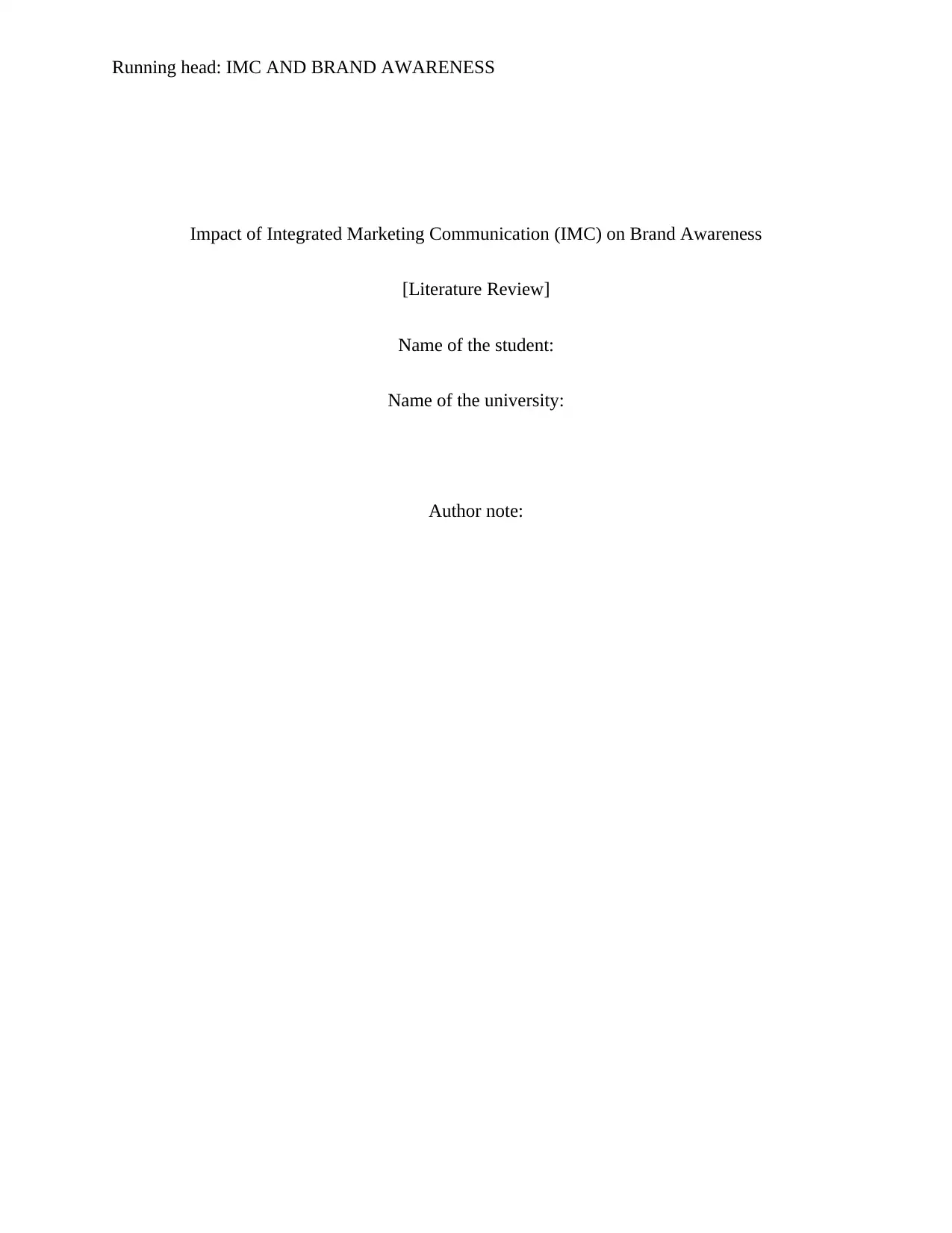
Running head: IMC AND BRAND AWARENESS
Impact of Integrated Marketing Communication (IMC) on Brand Awareness
[Literature Review]
Name of the student:
Name of the university:
Author note:
Impact of Integrated Marketing Communication (IMC) on Brand Awareness
[Literature Review]
Name of the student:
Name of the university:
Author note:
Paraphrase This Document
Need a fresh take? Get an instant paraphrase of this document with our AI Paraphraser
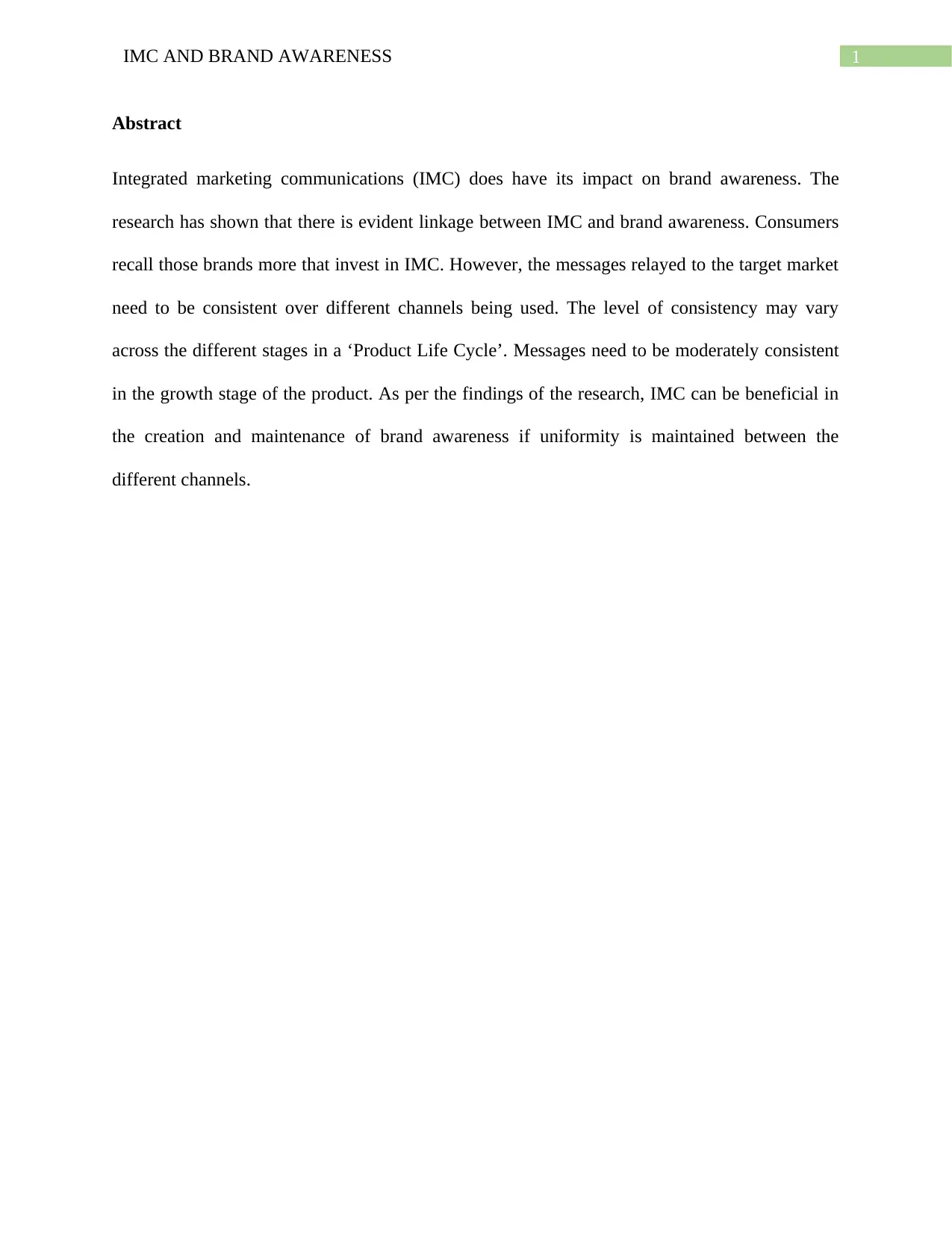
1IMC AND BRAND AWARENESS
Abstract
Integrated marketing communications (IMC) does have its impact on brand awareness. The
research has shown that there is evident linkage between IMC and brand awareness. Consumers
recall those brands more that invest in IMC. However, the messages relayed to the target market
need to be consistent over different channels being used. The level of consistency may vary
across the different stages in a ‘Product Life Cycle’. Messages need to be moderately consistent
in the growth stage of the product. As per the findings of the research, IMC can be beneficial in
the creation and maintenance of brand awareness if uniformity is maintained between the
different channels.
Abstract
Integrated marketing communications (IMC) does have its impact on brand awareness. The
research has shown that there is evident linkage between IMC and brand awareness. Consumers
recall those brands more that invest in IMC. However, the messages relayed to the target market
need to be consistent over different channels being used. The level of consistency may vary
across the different stages in a ‘Product Life Cycle’. Messages need to be moderately consistent
in the growth stage of the product. As per the findings of the research, IMC can be beneficial in
the creation and maintenance of brand awareness if uniformity is maintained between the
different channels.
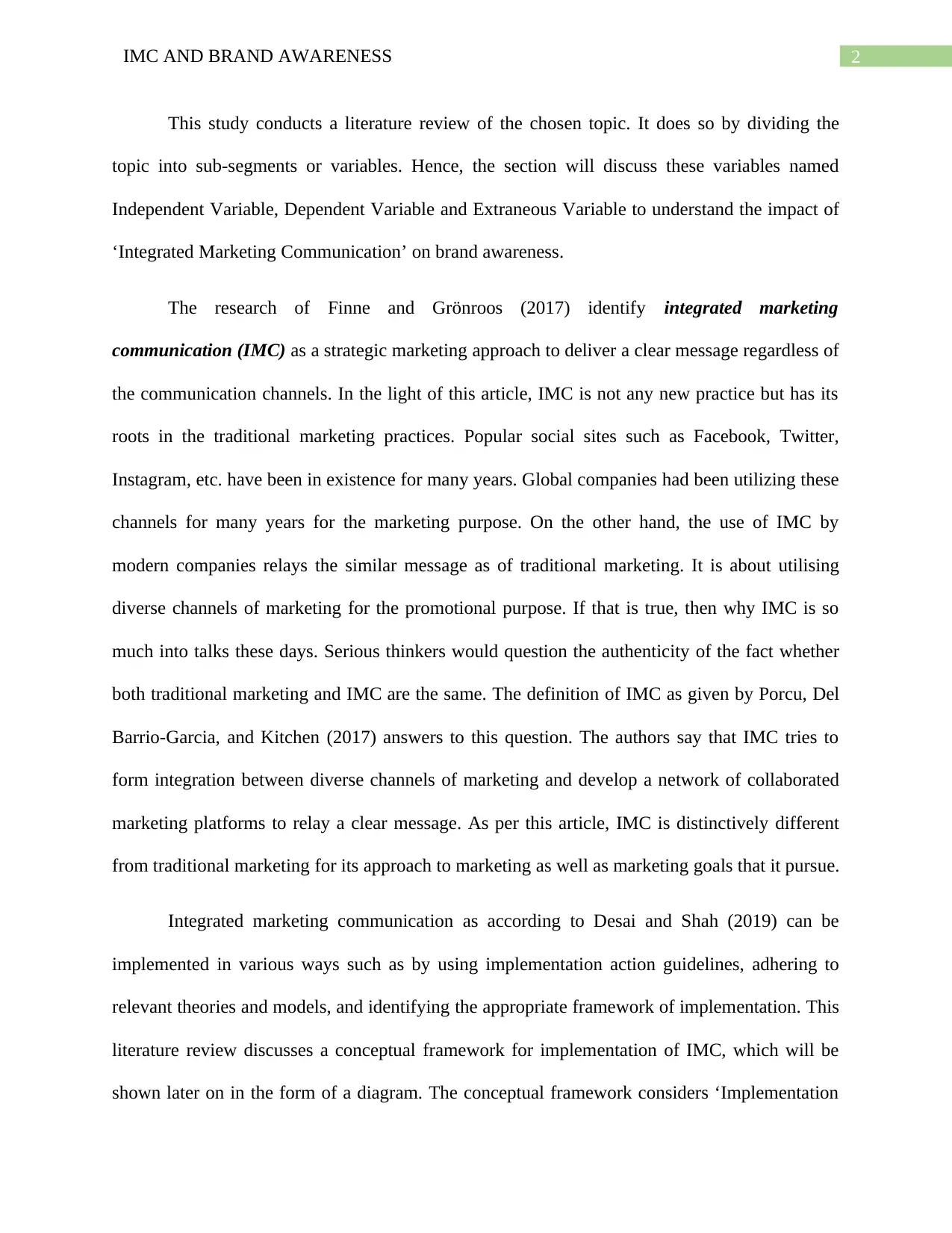
2IMC AND BRAND AWARENESS
This study conducts a literature review of the chosen topic. It does so by dividing the
topic into sub-segments or variables. Hence, the section will discuss these variables named
Independent Variable, Dependent Variable and Extraneous Variable to understand the impact of
‘Integrated Marketing Communication’ on brand awareness.
The research of Finne and Grönroos (2017) identify integrated marketing
communication (IMC) as a strategic marketing approach to deliver a clear message regardless of
the communication channels. In the light of this article, IMC is not any new practice but has its
roots in the traditional marketing practices. Popular social sites such as Facebook, Twitter,
Instagram, etc. have been in existence for many years. Global companies had been utilizing these
channels for many years for the marketing purpose. On the other hand, the use of IMC by
modern companies relays the similar message as of traditional marketing. It is about utilising
diverse channels of marketing for the promotional purpose. If that is true, then why IMC is so
much into talks these days. Serious thinkers would question the authenticity of the fact whether
both traditional marketing and IMC are the same. The definition of IMC as given by Porcu, Del
Barrio-Garcia, and Kitchen (2017) answers to this question. The authors say that IMC tries to
form integration between diverse channels of marketing and develop a network of collaborated
marketing platforms to relay a clear message. As per this article, IMC is distinctively different
from traditional marketing for its approach to marketing as well as marketing goals that it pursue.
Integrated marketing communication as according to Desai and Shah (2019) can be
implemented in various ways such as by using implementation action guidelines, adhering to
relevant theories and models, and identifying the appropriate framework of implementation. This
literature review discusses a conceptual framework for implementation of IMC, which will be
shown later on in the form of a diagram. The conceptual framework considers ‘Implementation
This study conducts a literature review of the chosen topic. It does so by dividing the
topic into sub-segments or variables. Hence, the section will discuss these variables named
Independent Variable, Dependent Variable and Extraneous Variable to understand the impact of
‘Integrated Marketing Communication’ on brand awareness.
The research of Finne and Grönroos (2017) identify integrated marketing
communication (IMC) as a strategic marketing approach to deliver a clear message regardless of
the communication channels. In the light of this article, IMC is not any new practice but has its
roots in the traditional marketing practices. Popular social sites such as Facebook, Twitter,
Instagram, etc. have been in existence for many years. Global companies had been utilizing these
channels for many years for the marketing purpose. On the other hand, the use of IMC by
modern companies relays the similar message as of traditional marketing. It is about utilising
diverse channels of marketing for the promotional purpose. If that is true, then why IMC is so
much into talks these days. Serious thinkers would question the authenticity of the fact whether
both traditional marketing and IMC are the same. The definition of IMC as given by Porcu, Del
Barrio-Garcia, and Kitchen (2017) answers to this question. The authors say that IMC tries to
form integration between diverse channels of marketing and develop a network of collaborated
marketing platforms to relay a clear message. As per this article, IMC is distinctively different
from traditional marketing for its approach to marketing as well as marketing goals that it pursue.
Integrated marketing communication as according to Desai and Shah (2019) can be
implemented in various ways such as by using implementation action guidelines, adhering to
relevant theories and models, and identifying the appropriate framework of implementation. This
literature review discusses a conceptual framework for implementation of IMC, which will be
shown later on in the form of a diagram. The conceptual framework considers ‘Implementation
⊘ This is a preview!⊘
Do you want full access?
Subscribe today to unlock all pages.

Trusted by 1+ million students worldwide
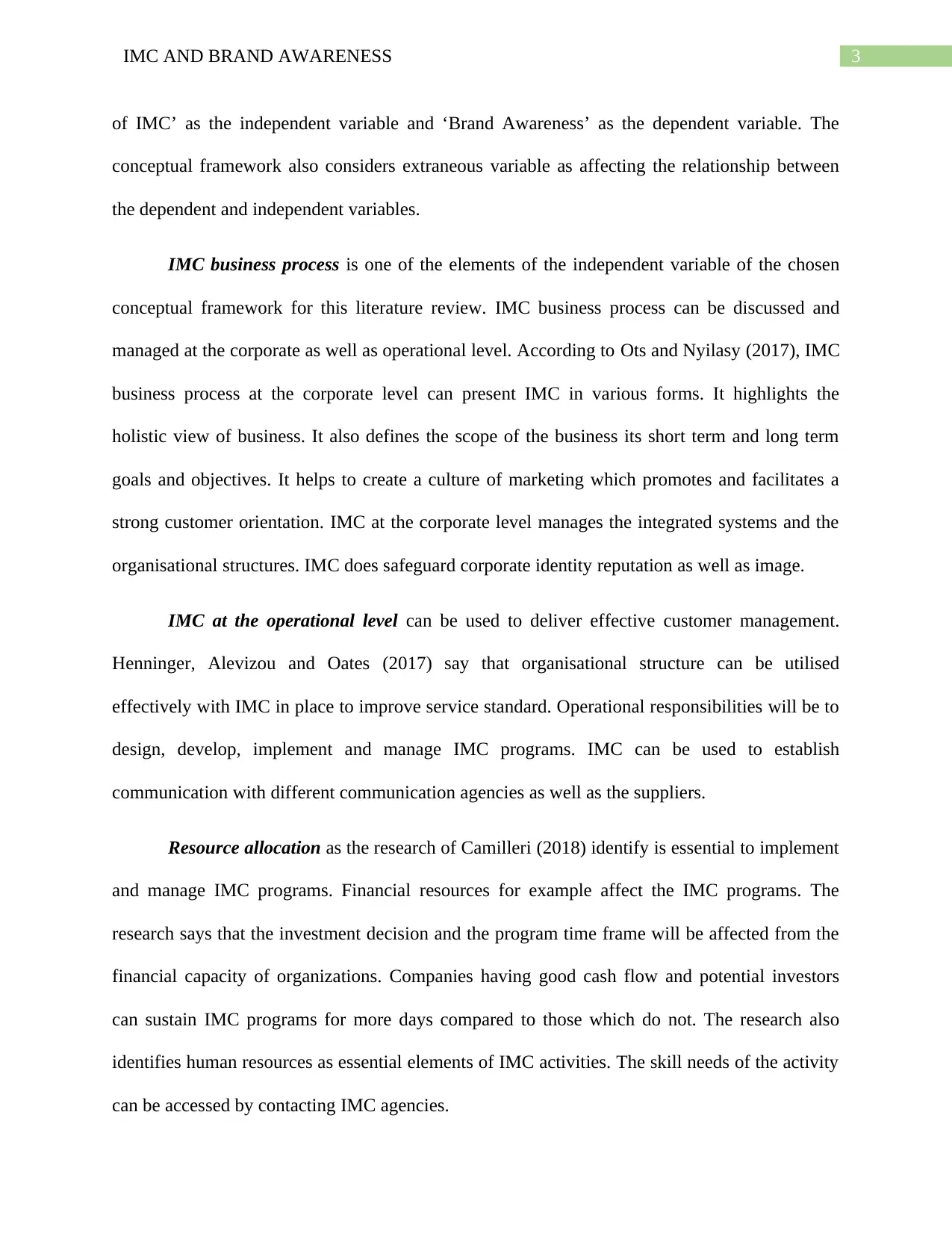
3IMC AND BRAND AWARENESS
of IMC’ as the independent variable and ‘Brand Awareness’ as the dependent variable. The
conceptual framework also considers extraneous variable as affecting the relationship between
the dependent and independent variables.
IMC business process is one of the elements of the independent variable of the chosen
conceptual framework for this literature review. IMC business process can be discussed and
managed at the corporate as well as operational level. According to Ots and Nyilasy (2017), IMC
business process at the corporate level can present IMC in various forms. It highlights the
holistic view of business. It also defines the scope of the business its short term and long term
goals and objectives. It helps to create a culture of marketing which promotes and facilitates a
strong customer orientation. IMC at the corporate level manages the integrated systems and the
organisational structures. IMC does safeguard corporate identity reputation as well as image.
IMC at the operational level can be used to deliver effective customer management.
Henninger, Alevizou and Oates (2017) say that organisational structure can be utilised
effectively with IMC in place to improve service standard. Operational responsibilities will be to
design, develop, implement and manage IMC programs. IMC can be used to establish
communication with different communication agencies as well as the suppliers.
Resource allocation as the research of Camilleri (2018) identify is essential to implement
and manage IMC programs. Financial resources for example affect the IMC programs. The
research says that the investment decision and the program time frame will be affected from the
financial capacity of organizations. Companies having good cash flow and potential investors
can sustain IMC programs for more days compared to those which do not. The research also
identifies human resources as essential elements of IMC activities. The skill needs of the activity
can be accessed by contacting IMC agencies.
of IMC’ as the independent variable and ‘Brand Awareness’ as the dependent variable. The
conceptual framework also considers extraneous variable as affecting the relationship between
the dependent and independent variables.
IMC business process is one of the elements of the independent variable of the chosen
conceptual framework for this literature review. IMC business process can be discussed and
managed at the corporate as well as operational level. According to Ots and Nyilasy (2017), IMC
business process at the corporate level can present IMC in various forms. It highlights the
holistic view of business. It also defines the scope of the business its short term and long term
goals and objectives. It helps to create a culture of marketing which promotes and facilitates a
strong customer orientation. IMC at the corporate level manages the integrated systems and the
organisational structures. IMC does safeguard corporate identity reputation as well as image.
IMC at the operational level can be used to deliver effective customer management.
Henninger, Alevizou and Oates (2017) say that organisational structure can be utilised
effectively with IMC in place to improve service standard. Operational responsibilities will be to
design, develop, implement and manage IMC programs. IMC can be used to establish
communication with different communication agencies as well as the suppliers.
Resource allocation as the research of Camilleri (2018) identify is essential to implement
and manage IMC programs. Financial resources for example affect the IMC programs. The
research says that the investment decision and the program time frame will be affected from the
financial capacity of organizations. Companies having good cash flow and potential investors
can sustain IMC programs for more days compared to those which do not. The research also
identifies human resources as essential elements of IMC activities. The skill needs of the activity
can be accessed by contacting IMC agencies.
Paraphrase This Document
Need a fresh take? Get an instant paraphrase of this document with our AI Paraphraser
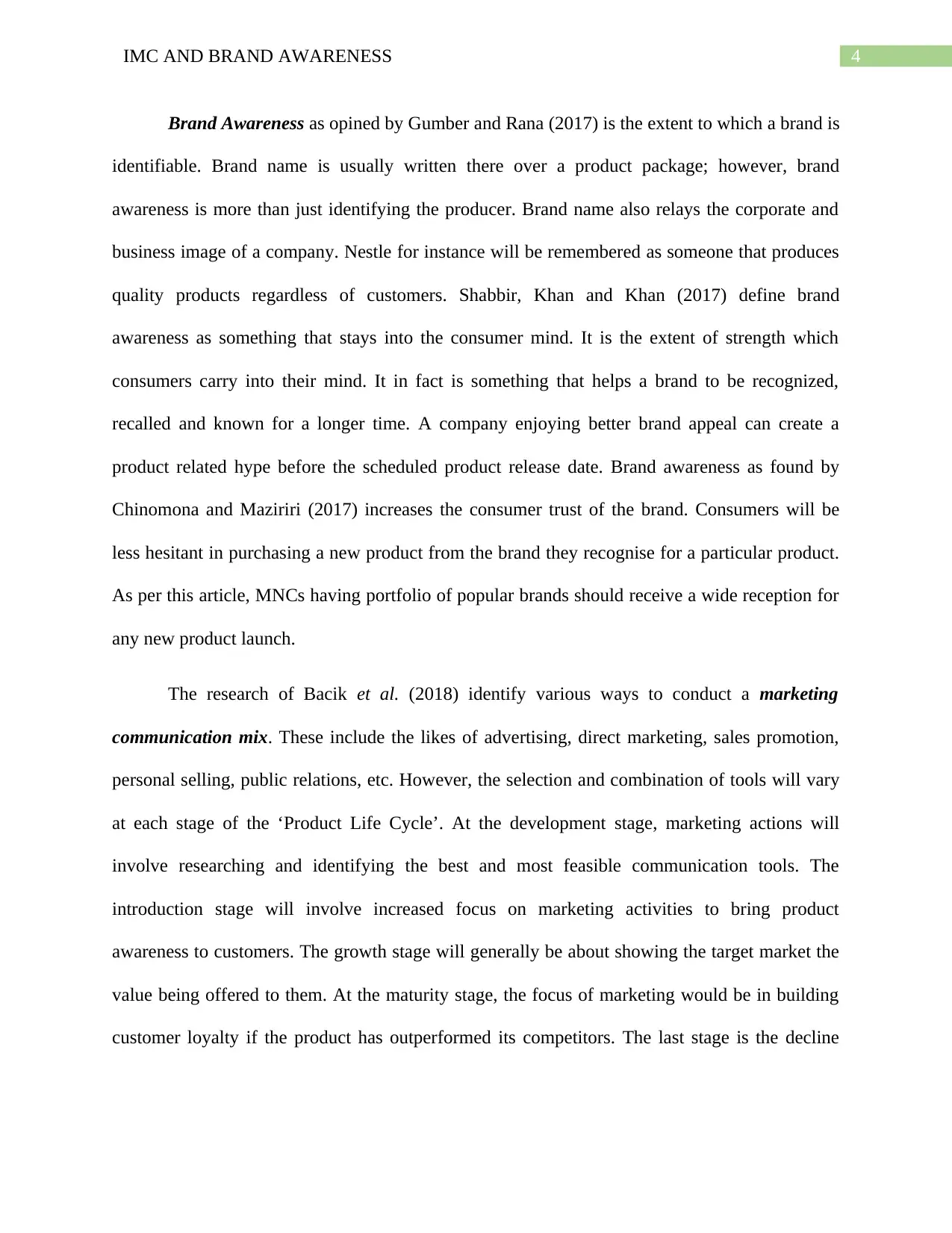
4IMC AND BRAND AWARENESS
Brand Awareness as opined by Gumber and Rana (2017) is the extent to which a brand is
identifiable. Brand name is usually written there over a product package; however, brand
awareness is more than just identifying the producer. Brand name also relays the corporate and
business image of a company. Nestle for instance will be remembered as someone that produces
quality products regardless of customers. Shabbir, Khan and Khan (2017) define brand
awareness as something that stays into the consumer mind. It is the extent of strength which
consumers carry into their mind. It in fact is something that helps a brand to be recognized,
recalled and known for a longer time. A company enjoying better brand appeal can create a
product related hype before the scheduled product release date. Brand awareness as found by
Chinomona and Maziriri (2017) increases the consumer trust of the brand. Consumers will be
less hesitant in purchasing a new product from the brand they recognise for a particular product.
As per this article, MNCs having portfolio of popular brands should receive a wide reception for
any new product launch.
The research of Bacik et al. (2018) identify various ways to conduct a marketing
communication mix. These include the likes of advertising, direct marketing, sales promotion,
personal selling, public relations, etc. However, the selection and combination of tools will vary
at each stage of the ‘Product Life Cycle’. At the development stage, marketing actions will
involve researching and identifying the best and most feasible communication tools. The
introduction stage will involve increased focus on marketing activities to bring product
awareness to customers. The growth stage will generally be about showing the target market the
value being offered to them. At the maturity stage, the focus of marketing would be in building
customer loyalty if the product has outperformed its competitors. The last stage is the decline
Brand Awareness as opined by Gumber and Rana (2017) is the extent to which a brand is
identifiable. Brand name is usually written there over a product package; however, brand
awareness is more than just identifying the producer. Brand name also relays the corporate and
business image of a company. Nestle for instance will be remembered as someone that produces
quality products regardless of customers. Shabbir, Khan and Khan (2017) define brand
awareness as something that stays into the consumer mind. It is the extent of strength which
consumers carry into their mind. It in fact is something that helps a brand to be recognized,
recalled and known for a longer time. A company enjoying better brand appeal can create a
product related hype before the scheduled product release date. Brand awareness as found by
Chinomona and Maziriri (2017) increases the consumer trust of the brand. Consumers will be
less hesitant in purchasing a new product from the brand they recognise for a particular product.
As per this article, MNCs having portfolio of popular brands should receive a wide reception for
any new product launch.
The research of Bacik et al. (2018) identify various ways to conduct a marketing
communication mix. These include the likes of advertising, direct marketing, sales promotion,
personal selling, public relations, etc. However, the selection and combination of tools will vary
at each stage of the ‘Product Life Cycle’. At the development stage, marketing actions will
involve researching and identifying the best and most feasible communication tools. The
introduction stage will involve increased focus on marketing activities to bring product
awareness to customers. The growth stage will generally be about showing the target market the
value being offered to them. At the maturity stage, the focus of marketing would be in building
customer loyalty if the product has outperformed its competitors. The last stage is the decline
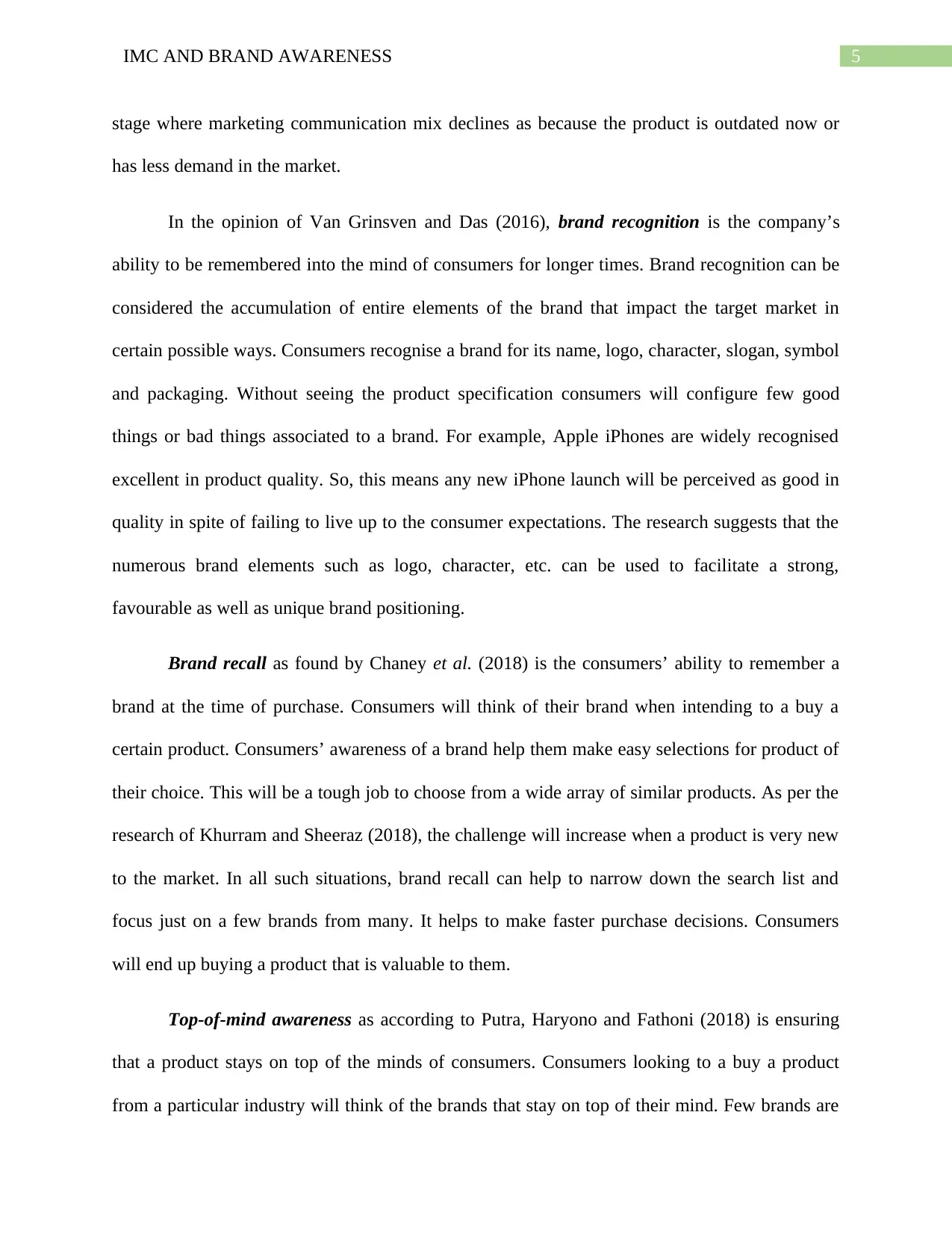
5IMC AND BRAND AWARENESS
stage where marketing communication mix declines as because the product is outdated now or
has less demand in the market.
In the opinion of Van Grinsven and Das (2016), brand recognition is the company’s
ability to be remembered into the mind of consumers for longer times. Brand recognition can be
considered the accumulation of entire elements of the brand that impact the target market in
certain possible ways. Consumers recognise a brand for its name, logo, character, slogan, symbol
and packaging. Without seeing the product specification consumers will configure few good
things or bad things associated to a brand. For example, Apple iPhones are widely recognised
excellent in product quality. So, this means any new iPhone launch will be perceived as good in
quality in spite of failing to live up to the consumer expectations. The research suggests that the
numerous brand elements such as logo, character, etc. can be used to facilitate a strong,
favourable as well as unique brand positioning.
Brand recall as found by Chaney et al. (2018) is the consumers’ ability to remember a
brand at the time of purchase. Consumers will think of their brand when intending to a buy a
certain product. Consumers’ awareness of a brand help them make easy selections for product of
their choice. This will be a tough job to choose from a wide array of similar products. As per the
research of Khurram and Sheeraz (2018), the challenge will increase when a product is very new
to the market. In all such situations, brand recall can help to narrow down the search list and
focus just on a few brands from many. It helps to make faster purchase decisions. Consumers
will end up buying a product that is valuable to them.
Top-of-mind awareness as according to Putra, Haryono and Fathoni (2018) is ensuring
that a product stays on top of the minds of consumers. Consumers looking to a buy a product
from a particular industry will think of the brands that stay on top of their mind. Few brands are
stage where marketing communication mix declines as because the product is outdated now or
has less demand in the market.
In the opinion of Van Grinsven and Das (2016), brand recognition is the company’s
ability to be remembered into the mind of consumers for longer times. Brand recognition can be
considered the accumulation of entire elements of the brand that impact the target market in
certain possible ways. Consumers recognise a brand for its name, logo, character, slogan, symbol
and packaging. Without seeing the product specification consumers will configure few good
things or bad things associated to a brand. For example, Apple iPhones are widely recognised
excellent in product quality. So, this means any new iPhone launch will be perceived as good in
quality in spite of failing to live up to the consumer expectations. The research suggests that the
numerous brand elements such as logo, character, etc. can be used to facilitate a strong,
favourable as well as unique brand positioning.
Brand recall as found by Chaney et al. (2018) is the consumers’ ability to remember a
brand at the time of purchase. Consumers will think of their brand when intending to a buy a
certain product. Consumers’ awareness of a brand help them make easy selections for product of
their choice. This will be a tough job to choose from a wide array of similar products. As per the
research of Khurram and Sheeraz (2018), the challenge will increase when a product is very new
to the market. In all such situations, brand recall can help to narrow down the search list and
focus just on a few brands from many. It helps to make faster purchase decisions. Consumers
will end up buying a product that is valuable to them.
Top-of-mind awareness as according to Putra, Haryono and Fathoni (2018) is ensuring
that a product stays on top of the minds of consumers. Consumers looking to a buy a product
from a particular industry will think of the brands that stay on top of their mind. Few brands are
⊘ This is a preview!⊘
Do you want full access?
Subscribe today to unlock all pages.

Trusted by 1+ million students worldwide
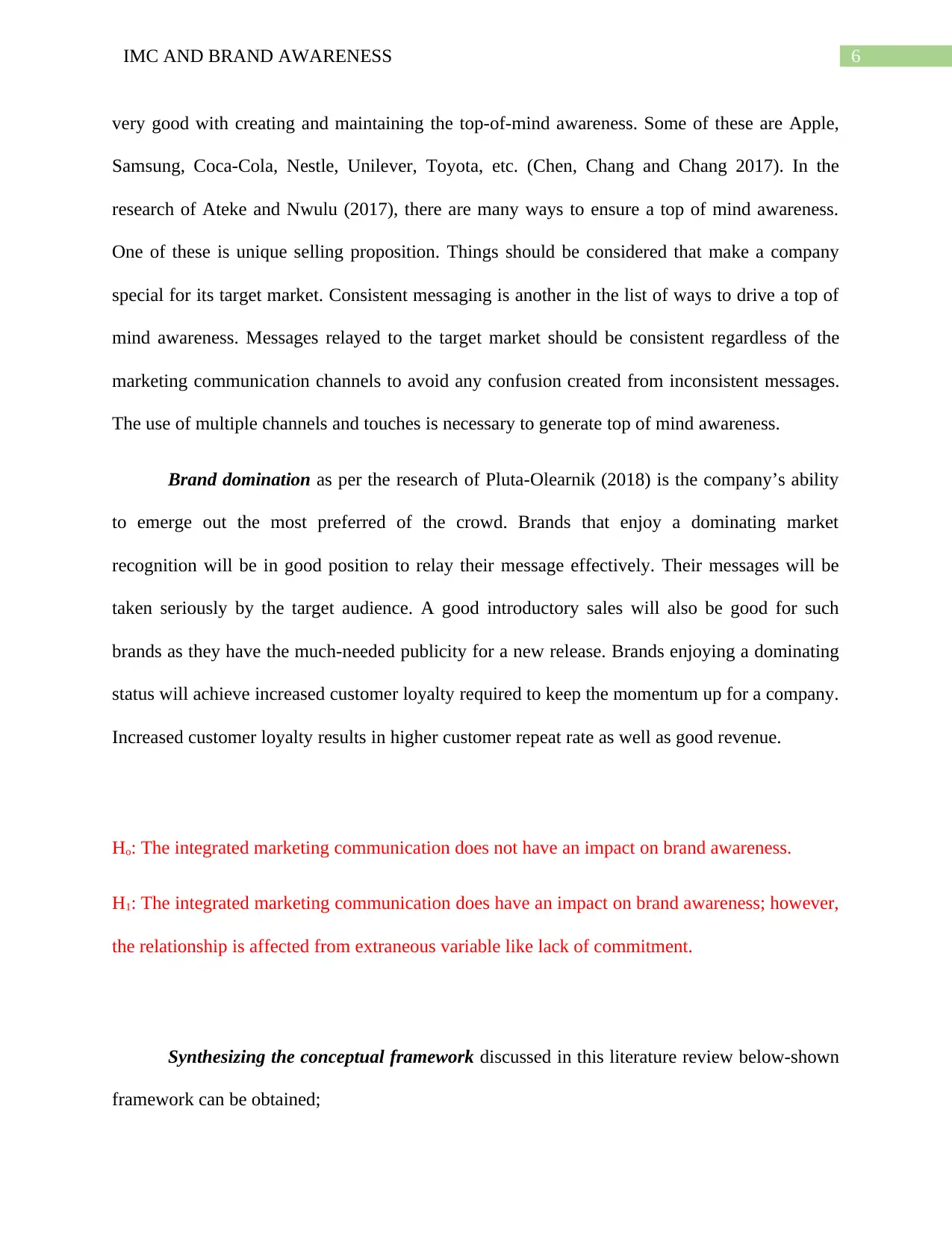
6IMC AND BRAND AWARENESS
very good with creating and maintaining the top-of-mind awareness. Some of these are Apple,
Samsung, Coca-Cola, Nestle, Unilever, Toyota, etc. (Chen, Chang and Chang 2017). In the
research of Ateke and Nwulu (2017), there are many ways to ensure a top of mind awareness.
One of these is unique selling proposition. Things should be considered that make a company
special for its target market. Consistent messaging is another in the list of ways to drive a top of
mind awareness. Messages relayed to the target market should be consistent regardless of the
marketing communication channels to avoid any confusion created from inconsistent messages.
The use of multiple channels and touches is necessary to generate top of mind awareness.
Brand domination as per the research of Pluta-Olearnik (2018) is the company’s ability
to emerge out the most preferred of the crowd. Brands that enjoy a dominating market
recognition will be in good position to relay their message effectively. Their messages will be
taken seriously by the target audience. A good introductory sales will also be good for such
brands as they have the much-needed publicity for a new release. Brands enjoying a dominating
status will achieve increased customer loyalty required to keep the momentum up for a company.
Increased customer loyalty results in higher customer repeat rate as well as good revenue.
Ho: The integrated marketing communication does not have an impact on brand awareness.
H1: The integrated marketing communication does have an impact on brand awareness; however,
the relationship is affected from extraneous variable like lack of commitment.
Synthesizing the conceptual framework discussed in this literature review below-shown
framework can be obtained;
very good with creating and maintaining the top-of-mind awareness. Some of these are Apple,
Samsung, Coca-Cola, Nestle, Unilever, Toyota, etc. (Chen, Chang and Chang 2017). In the
research of Ateke and Nwulu (2017), there are many ways to ensure a top of mind awareness.
One of these is unique selling proposition. Things should be considered that make a company
special for its target market. Consistent messaging is another in the list of ways to drive a top of
mind awareness. Messages relayed to the target market should be consistent regardless of the
marketing communication channels to avoid any confusion created from inconsistent messages.
The use of multiple channels and touches is necessary to generate top of mind awareness.
Brand domination as per the research of Pluta-Olearnik (2018) is the company’s ability
to emerge out the most preferred of the crowd. Brands that enjoy a dominating market
recognition will be in good position to relay their message effectively. Their messages will be
taken seriously by the target audience. A good introductory sales will also be good for such
brands as they have the much-needed publicity for a new release. Brands enjoying a dominating
status will achieve increased customer loyalty required to keep the momentum up for a company.
Increased customer loyalty results in higher customer repeat rate as well as good revenue.
Ho: The integrated marketing communication does not have an impact on brand awareness.
H1: The integrated marketing communication does have an impact on brand awareness; however,
the relationship is affected from extraneous variable like lack of commitment.
Synthesizing the conceptual framework discussed in this literature review below-shown
framework can be obtained;
Paraphrase This Document
Need a fresh take? Get an instant paraphrase of this document with our AI Paraphraser
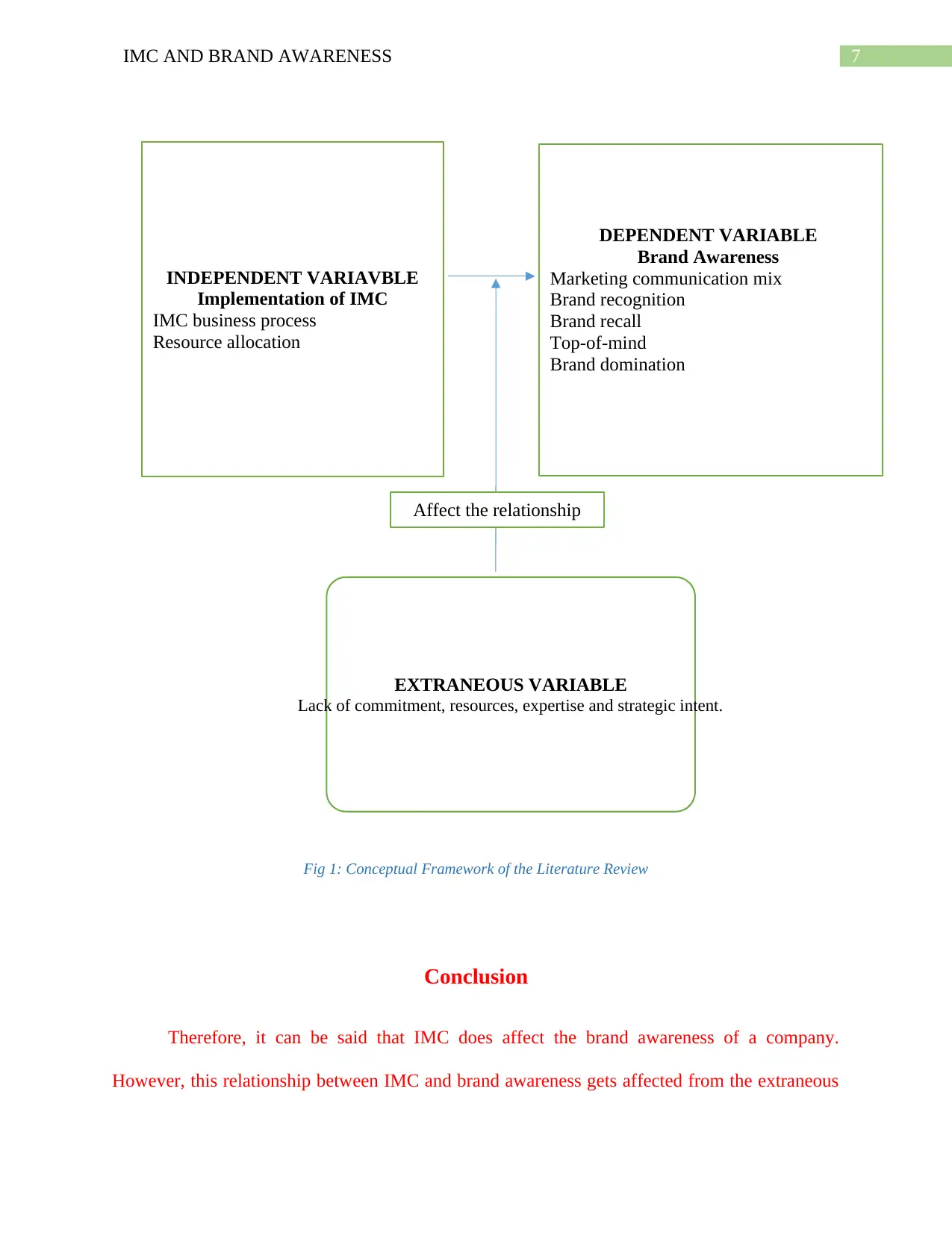
7IMC AND BRAND AWARENESS
INDEPENDENT VARIAVBLE
Implementation of IMC
IMC business process
Resource allocation
DEPENDENT VARIABLE
Brand Awareness
Marketing communication mix
Brand recognition
Brand recall
Top-of-mind
Brand domination
EXTRANEOUS VARIABLE
Lack of commitment, resources, expertise and strategic intent.
Affect the relationship
Fig 1: Conceptual Framework of the Literature Review
Conclusion
Therefore, it can be said that IMC does affect the brand awareness of a company.
However, this relationship between IMC and brand awareness gets affected from the extraneous
INDEPENDENT VARIAVBLE
Implementation of IMC
IMC business process
Resource allocation
DEPENDENT VARIABLE
Brand Awareness
Marketing communication mix
Brand recognition
Brand recall
Top-of-mind
Brand domination
EXTRANEOUS VARIABLE
Lack of commitment, resources, expertise and strategic intent.
Affect the relationship
Fig 1: Conceptual Framework of the Literature Review
Conclusion
Therefore, it can be said that IMC does affect the brand awareness of a company.
However, this relationship between IMC and brand awareness gets affected from the extraneous
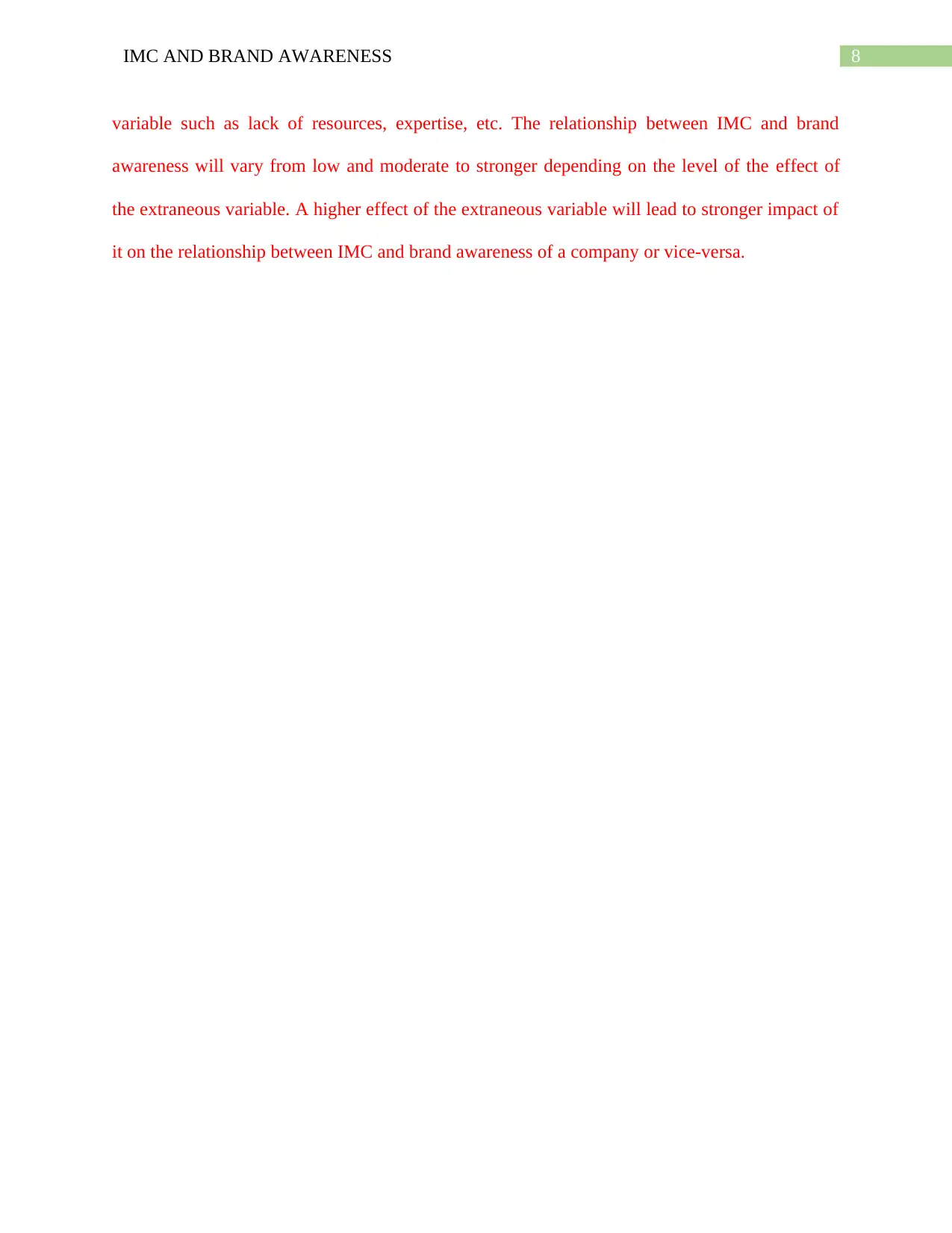
8IMC AND BRAND AWARENESS
variable such as lack of resources, expertise, etc. The relationship between IMC and brand
awareness will vary from low and moderate to stronger depending on the level of the effect of
the extraneous variable. A higher effect of the extraneous variable will lead to stronger impact of
it on the relationship between IMC and brand awareness of a company or vice-versa.
variable such as lack of resources, expertise, etc. The relationship between IMC and brand
awareness will vary from low and moderate to stronger depending on the level of the effect of
the extraneous variable. A higher effect of the extraneous variable will lead to stronger impact of
it on the relationship between IMC and brand awareness of a company or vice-versa.
⊘ This is a preview!⊘
Do you want full access?
Subscribe today to unlock all pages.

Trusted by 1+ million students worldwide
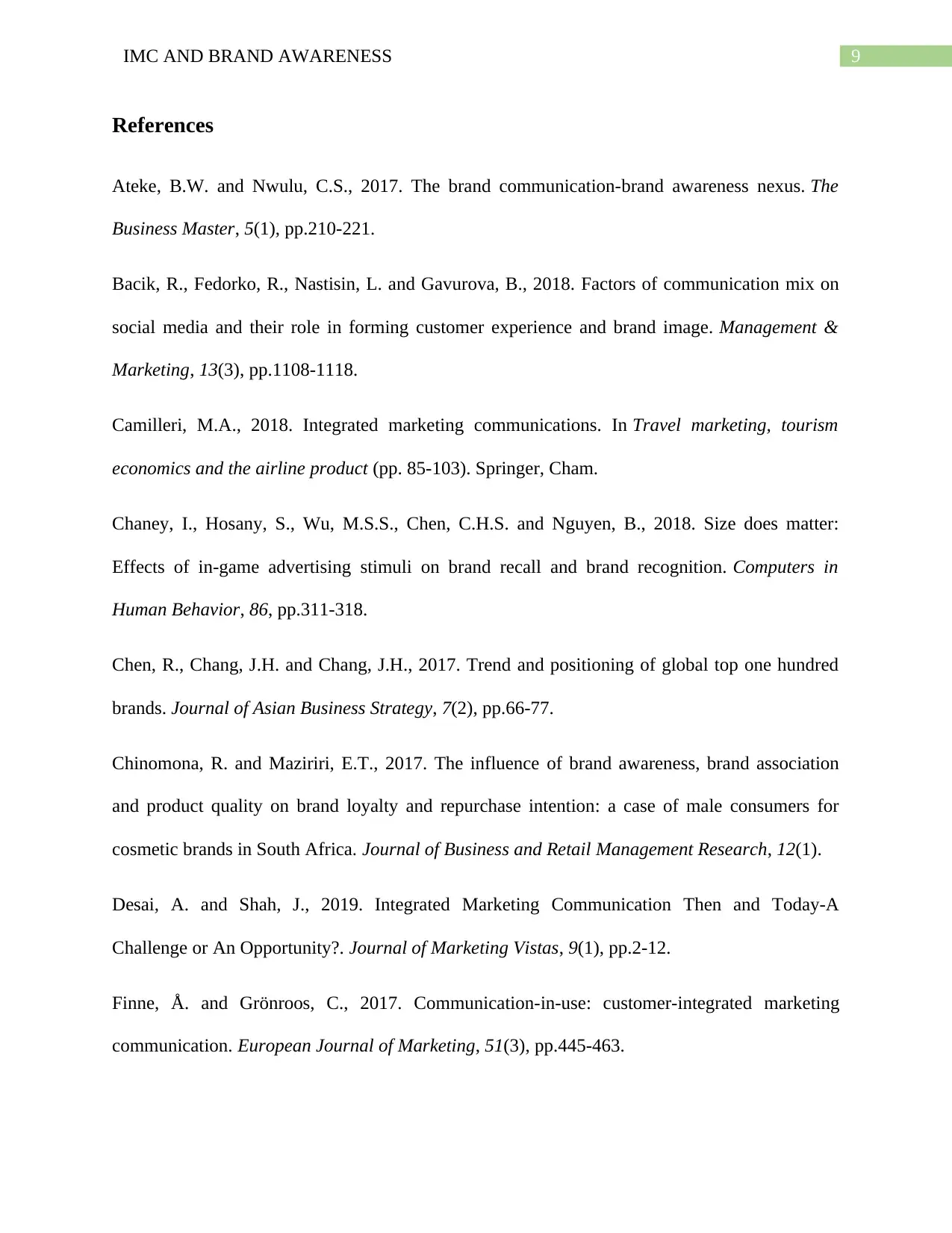
9IMC AND BRAND AWARENESS
References
Ateke, B.W. and Nwulu, C.S., 2017. The brand communication-brand awareness nexus. The
Business Master, 5(1), pp.210-221.
Bacik, R., Fedorko, R., Nastisin, L. and Gavurova, B., 2018. Factors of communication mix on
social media and their role in forming customer experience and brand image. Management &
Marketing, 13(3), pp.1108-1118.
Camilleri, M.A., 2018. Integrated marketing communications. In Travel marketing, tourism
economics and the airline product (pp. 85-103). Springer, Cham.
Chaney, I., Hosany, S., Wu, M.S.S., Chen, C.H.S. and Nguyen, B., 2018. Size does matter:
Effects of in-game advertising stimuli on brand recall and brand recognition. Computers in
Human Behavior, 86, pp.311-318.
Chen, R., Chang, J.H. and Chang, J.H., 2017. Trend and positioning of global top one hundred
brands. Journal of Asian Business Strategy, 7(2), pp.66-77.
Chinomona, R. and Maziriri, E.T., 2017. The influence of brand awareness, brand association
and product quality on brand loyalty and repurchase intention: a case of male consumers for
cosmetic brands in South Africa. Journal of Business and Retail Management Research, 12(1).
Desai, A. and Shah, J., 2019. Integrated Marketing Communication Then and Today-A
Challenge or An Opportunity?. Journal of Marketing Vistas, 9(1), pp.2-12.
Finne, Å. and Grönroos, C., 2017. Communication-in-use: customer-integrated marketing
communication. European Journal of Marketing, 51(3), pp.445-463.
References
Ateke, B.W. and Nwulu, C.S., 2017. The brand communication-brand awareness nexus. The
Business Master, 5(1), pp.210-221.
Bacik, R., Fedorko, R., Nastisin, L. and Gavurova, B., 2018. Factors of communication mix on
social media and their role in forming customer experience and brand image. Management &
Marketing, 13(3), pp.1108-1118.
Camilleri, M.A., 2018. Integrated marketing communications. In Travel marketing, tourism
economics and the airline product (pp. 85-103). Springer, Cham.
Chaney, I., Hosany, S., Wu, M.S.S., Chen, C.H.S. and Nguyen, B., 2018. Size does matter:
Effects of in-game advertising stimuli on brand recall and brand recognition. Computers in
Human Behavior, 86, pp.311-318.
Chen, R., Chang, J.H. and Chang, J.H., 2017. Trend and positioning of global top one hundred
brands. Journal of Asian Business Strategy, 7(2), pp.66-77.
Chinomona, R. and Maziriri, E.T., 2017. The influence of brand awareness, brand association
and product quality on brand loyalty and repurchase intention: a case of male consumers for
cosmetic brands in South Africa. Journal of Business and Retail Management Research, 12(1).
Desai, A. and Shah, J., 2019. Integrated Marketing Communication Then and Today-A
Challenge or An Opportunity?. Journal of Marketing Vistas, 9(1), pp.2-12.
Finne, Å. and Grönroos, C., 2017. Communication-in-use: customer-integrated marketing
communication. European Journal of Marketing, 51(3), pp.445-463.
Paraphrase This Document
Need a fresh take? Get an instant paraphrase of this document with our AI Paraphraser
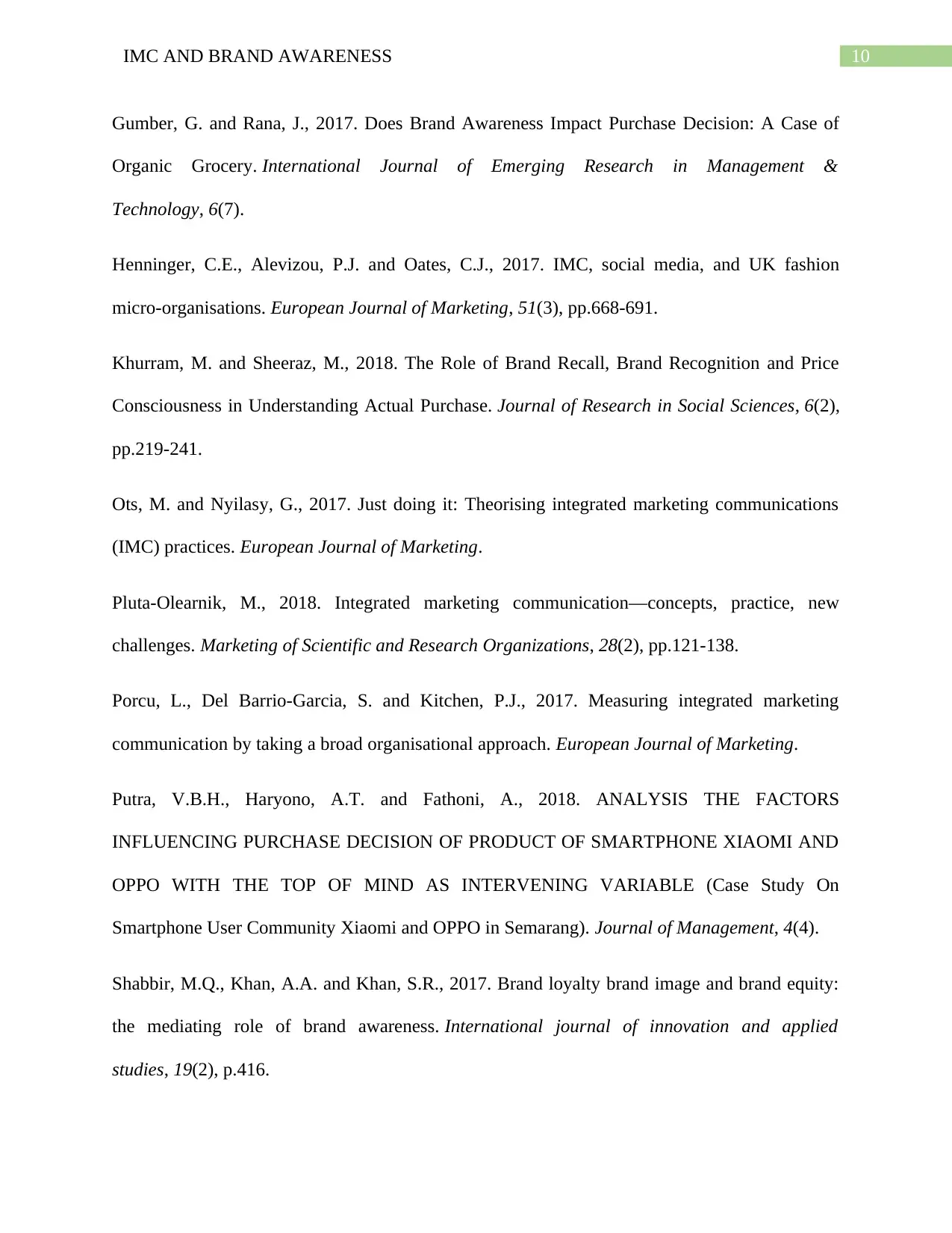
10IMC AND BRAND AWARENESS
Gumber, G. and Rana, J., 2017. Does Brand Awareness Impact Purchase Decision: A Case of
Organic Grocery. International Journal of Emerging Research in Management &
Technology, 6(7).
Henninger, C.E., Alevizou, P.J. and Oates, C.J., 2017. IMC, social media, and UK fashion
micro-organisations. European Journal of Marketing, 51(3), pp.668-691.
Khurram, M. and Sheeraz, M., 2018. The Role of Brand Recall, Brand Recognition and Price
Consciousness in Understanding Actual Purchase. Journal of Research in Social Sciences, 6(2),
pp.219-241.
Ots, M. and Nyilasy, G., 2017. Just doing it: Theorising integrated marketing communications
(IMC) practices. European Journal of Marketing.
Pluta-Olearnik, M., 2018. Integrated marketing communication—concepts, practice, new
challenges. Marketing of Scientific and Research Organizations, 28(2), pp.121-138.
Porcu, L., Del Barrio-Garcia, S. and Kitchen, P.J., 2017. Measuring integrated marketing
communication by taking a broad organisational approach. European Journal of Marketing.
Putra, V.B.H., Haryono, A.T. and Fathoni, A., 2018. ANALYSIS THE FACTORS
INFLUENCING PURCHASE DECISION OF PRODUCT OF SMARTPHONE XIAOMI AND
OPPO WITH THE TOP OF MIND AS INTERVENING VARIABLE (Case Study On
Smartphone User Community Xiaomi and OPPO in Semarang). Journal of Management, 4(4).
Shabbir, M.Q., Khan, A.A. and Khan, S.R., 2017. Brand loyalty brand image and brand equity:
the mediating role of brand awareness. International journal of innovation and applied
studies, 19(2), p.416.
Gumber, G. and Rana, J., 2017. Does Brand Awareness Impact Purchase Decision: A Case of
Organic Grocery. International Journal of Emerging Research in Management &
Technology, 6(7).
Henninger, C.E., Alevizou, P.J. and Oates, C.J., 2017. IMC, social media, and UK fashion
micro-organisations. European Journal of Marketing, 51(3), pp.668-691.
Khurram, M. and Sheeraz, M., 2018. The Role of Brand Recall, Brand Recognition and Price
Consciousness in Understanding Actual Purchase. Journal of Research in Social Sciences, 6(2),
pp.219-241.
Ots, M. and Nyilasy, G., 2017. Just doing it: Theorising integrated marketing communications
(IMC) practices. European Journal of Marketing.
Pluta-Olearnik, M., 2018. Integrated marketing communication—concepts, practice, new
challenges. Marketing of Scientific and Research Organizations, 28(2), pp.121-138.
Porcu, L., Del Barrio-Garcia, S. and Kitchen, P.J., 2017. Measuring integrated marketing
communication by taking a broad organisational approach. European Journal of Marketing.
Putra, V.B.H., Haryono, A.T. and Fathoni, A., 2018. ANALYSIS THE FACTORS
INFLUENCING PURCHASE DECISION OF PRODUCT OF SMARTPHONE XIAOMI AND
OPPO WITH THE TOP OF MIND AS INTERVENING VARIABLE (Case Study On
Smartphone User Community Xiaomi and OPPO in Semarang). Journal of Management, 4(4).
Shabbir, M.Q., Khan, A.A. and Khan, S.R., 2017. Brand loyalty brand image and brand equity:
the mediating role of brand awareness. International journal of innovation and applied
studies, 19(2), p.416.
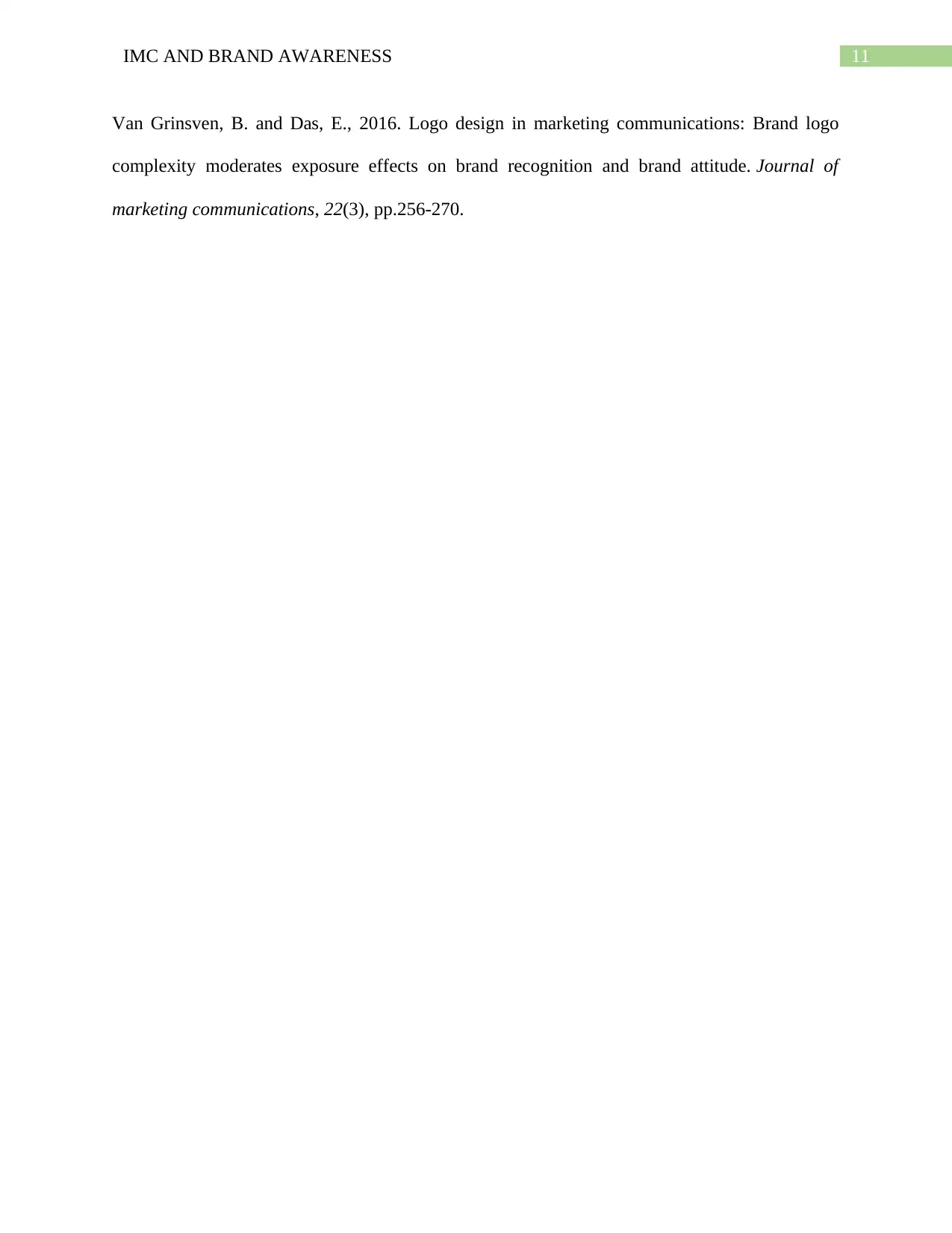
11IMC AND BRAND AWARENESS
Van Grinsven, B. and Das, E., 2016. Logo design in marketing communications: Brand logo
complexity moderates exposure effects on brand recognition and brand attitude. Journal of
marketing communications, 22(3), pp.256-270.
Van Grinsven, B. and Das, E., 2016. Logo design in marketing communications: Brand logo
complexity moderates exposure effects on brand recognition and brand attitude. Journal of
marketing communications, 22(3), pp.256-270.
⊘ This is a preview!⊘
Do you want full access?
Subscribe today to unlock all pages.

Trusted by 1+ million students worldwide
1 out of 12
Related Documents
Your All-in-One AI-Powered Toolkit for Academic Success.
+13062052269
info@desklib.com
Available 24*7 on WhatsApp / Email
![[object Object]](/_next/static/media/star-bottom.7253800d.svg)
Unlock your academic potential
Copyright © 2020–2025 A2Z Services. All Rights Reserved. Developed and managed by ZUCOL.





